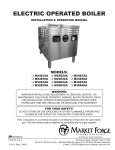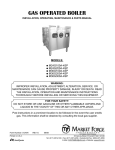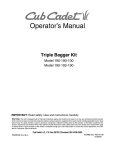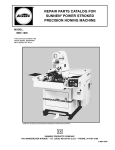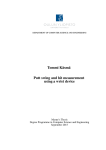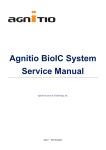Download Market Forge Industries M-60 Operating instructions
Transcript
ELECTRIC OPERATED BOILER INSTALLATION, OPERATING, MAINTENANCE AND PARTS MANUAL MODELS: □ M24E24A □ M24E42A □ M36E24A □ M36E42A □ M24E32A □ M24E48A □ M36E32A □ M36E48A □ M24E36A □ M36E24A □ M36E36A WARNING: IMPROPER INSTALLATION, ADJUSTMENT, ALTERATION, SERVICE OR MAINTENANCE CAN CAUSE PROPERTY DAMAGE, INJURY OR DEATH. READ THE INSTALLATION, OPERATION AND MAINTENANCE INSTRUCTIONS THOROUGHLY BEFORE INSTALLING OR SERVICING THIS EQUIPMENT. FOR YOUR SAFETY: DO NOT STORE OR USE GASOLINE OR OTHER FLAMMABLE VAPORS AND LIQUIDS IN THE VICINITY OF THIS OR ANY OTHER APPLIANCE. Post instructions in a prominent location to be followed in the event the user smells gas. This information shall be obtained by consulting the local gas supplier. Printed in U.S.A. Form No S-3112 Rev. D 35 Garvey Street, Everett, MA 02149 Tel: (617) 387-4100, (866) 698-3188, Fax: (617) 387-4456, (800) 227-2659 [email protected], www.mfii.com TABLE OF CONTENTS ____________________________________________________________________________ ○ INTRODUCTION . ............................................................................................................. ▪ TO THE KITCHEN MANAGER..................................................................................... ▪ INTRODUCTION........................................................................................................... ▪ HOW TO USE THIS MANUAL ..................................................................................... ▪ THEORY OF OPERATION FOR ELECTRIC BOILER.................................................. i i i i i ○ INSTALLATION INSTRUCTIONS ..................................................................................... ▪ ELECTRIC OPERATED BOILERS............................................................................... ▪ RECEIVING INSTRUCTIONS....................................................................................... ▪ INSTALLING LEGS....................................................................................................... ▪ LEVELING . .................................................................................................................. ▪ SERVICE CONNECTIONS .......................................................................................... 1-2 1 1 1 1 2 ○ OPERATING INSTRUCTIONS.......................................................................................... ▪ OPERATING INSTRUCTIONS FOR STEAM GENERATORS...................................... ▪ DAILY OPERATING PROCEDURE.............................................................................. ▪ DAILY SHUT DOWN AND CLEANING......................................................................... 3 3 3 3 ○ ADJUSTMENTS ................................................................................................................ ▪ IF GAS PRESSURE IS LOW........................................................................................ ▪ IF GAS PRESSURE IS TOO HIGH............................................................................... ▪ SETTING OR BOILER CONTROL PRESSURE SWITCHES....................................... ▪ PRESSURE CONTROL SWITCH ADJUSTMENT ....................................................... 4-5 4 4 5 5 ○ ELECTRICAL INFORMATION........................................................................................... 6-12 ○ MAINTENANCE ................................................................................................................13-14 ○ APPLICATION INSTRUCTIONS .......................................................................................15-16 ○ GENERAL TROUBLE-SHOOTING GUIDE........................................................................17-20 ○ ILLUSTRATED PARTS LIST..............................................................................................21-27 ▪ BOILER BASE CABINET.............................................................................................. 21 ▪ PRESSURE SWITCH BOX WITHOUT COVER........................................................... 22 ▪ CONTROL BOX ASSEMBLY WITH AND WITHOUT COVER...................................... 23 ▪ SIDE VIEW, ELECTRIC BOILER ................................................................................. 24 ▪ FRONT VIEW, ELECTRIC BOILER.............................................................................. 25 ▪ CONTACTOR BOX WITHOUT COVER . ..................................................................... 26 ▪ ELEMENTS .................................................................................................................. 27 INTRODUCTION ____________________________________________________________________________ TO THE KITCHEN MANAGER: 1. Read this manual carefully and in its entirety. Contact Market Forge Ind., Inc. for clarification if necessary. 2. Protect your kitchen personnel from scalding and other serious injury by providing training programs to acquaint all 3. equipment operators with the correct and safe methods of operation. 4. Operators must be made aware of the consequences of misuse. Steam producing equipment, no matter who the 5. manufacturer, is inherently dangerous when misused. The possibility of serious scalding always exists, the careless and/or untrained operator will be injured. 6. This equipment must be maintained according to the guidelines in this manual (see “maintenance”). Lack of maintenance 7. will lead to a potentially hazardous condition and possible liability. Operators should report any equipment malfunction immediately and steps must be taken to correct the problem before further use of the equipment is allowed. 8. Keep this manual for daily reference. INTRODUCTION: Market Forge, in the interest of both cost and efficiency has designed these steam boilers with the latest automatic controls in order to make it easier for the operator to use and maintain this equipment. Standard components are utilized on all models unless variances in size or capacity dictate a divergence from this policy for more efficiency of operation. This parts and service manual is written and illustrated to cover all steam boiler equipment that uses gas as a source of fuel other than those which have been custom designed under special order. HOW TO USE THIS MANUAL: The pictures of components are aids to the identification, disassembly and assembly of parts. The parts listing provides information necessary for the ordering of replacement parts (proper part names and part numbers). When requesting parts or service; always furnish the model and serial number of your complete unit, this will indicate to Market Forge Service Personnel the type of boiler that you have. This information can be found on the nameplate attached to the boiler frame. THEORY OF OPERATION FOR ELECTRIC BOILER: An explanation of how the control system operates on automatic electric boilers follows: With the boiler filled with water to the proper level and the fuel switch is turned ON, the contactors will pull in and permit the completion of the electric circuit to the heating element. When the boiler builds to its set pressure, the pressure switch opens. This will open the circuit to the coil in the contactor, which in turn will drop put the contacts in the contactor and shut off the electricity. As the pressure in the boiler drops the pressure control switch will again complete the circuit and build the boiler back to its set pressure. To stop all steam generation place the fuel switch to the OFF position. i INSTALLATION INSTRUCTIONS ____________________________________________________________________________ MODELS: □ M24E24A □ M24E48A □ M36E42A □ M24E32A □ M36E24A □ M36E48A □ M24E36A □ M36E32A □ M24E42A □ M36E36A WARNING: READ THIS BEFORE OPEING THE SHIPPING CONTAINERS !!!!!!!! CAUTION: BE SURE TO READ: DO NOT AT ANY TIME LAY THE EQUIPMENT DOWN ON ITS BACK, SIDE, TOP OR FRONT. Doing so may damage the equipment and invalidate the warranty. RECEIVING INSTRUCTIONS: Inspect the equipment before signing the bill of lading. The equipment supplied was tested and inspected before shipment. The carrier accepted it as complete and without damage. This merchandise became your property when it was accepted by the carrier at the factory. Market Forge cannot assume responsibility for loss or damage during transit. For this reason, you should immediately inspect for visible and concealed damage or shortages before signing for shipment as follows: 1. Count the number of cartons and packages received to be sure they coincide with the bill of lading. 2. Visually check all cartons for external damage. 3. Remove all cartons from their skids to examine equipment for concealed damage. The carton is nailed and strapped to the skid. It will be necessary to cut the straps and pry off the container. 4. After inspection, replace the cartons over the equipment on the skids to protect and secure the equipment until it is ready for installation. 5. Sign for shipment if all is in order. Note shortages, external and concealed damage, if any, on the bill of lading before accepting a partial or damaged shipment. 6. If necessary, contact the carrier immediately to file a claim. All claims must be filed by the receiver. 7. Do not remove the cartons or the skids from the cooking equipment until the unit has been transported through the building to the actual set-up location. The cartons should remain on the equipment as protection against dents and scratches. INSTALLING LEGS: Some models are shipped without legs. A separate carton will contain the legs. If your model is received this way, be sure to follow the installation instruction sheet packed with the legs. LEVELING: In order for the boiler to drain correctly, it is important to use a level on cabinet top both left and right and front-to-back. If not level, adjust feet. On compartment cookers, check the interior shelves for level condition. 1 INSTALLATION INSTRUCTIONS ____________________________________________________________________________ SERVICE CONNECTIONS Electrically Operated EP Power Supply - Use wire suitable for at least 90°C. Nominal amp per line wire: Volts 208 (197-219) 240 (220-240) 480 (360-500) 24 kW 32 kW 36 kW 42 kW 48 kW 3 pH 3 pH 3 pH 3 pH 3 pH 66 60 32 89 77 39 100 91 47 117 - 116 58 Details of other electrical systems available upon request. CW1 Cold Water - 3/8” (10mm) NPT for cold water to boiler. Cold water lines will have a maximum of 50 PSI (3.5kg/cw2) and a minimum of 25 PSI (1.8 kg/cw2) water pressure. CW2 Cold Water - 3/8” (10mm) NPT for cold water to condenser. Cold water lines will have a maximum of 50 PSI (3.5kg/cw2) and a minimum of 25 PSI (1.8 kg/cw2) water pressure. D Drain - Pipe full 2” (50mm) I.P.S. to flush floor drain capable of receiving water flowing at a maximum rate of 5 gallons (19 liters) per minute. DO NOT MAKE SOLID CONNECTION TO FLOOR DRAIN. ST Steam Take-off - Connection for operation of adjacent steam powered equipment. WARNING: DO NOT UNDER ANY CIRCUMSTANCE CONNECT THE EXHAUST DRAIN LINE DIRECTLY TO A SEWER LINE. NOTES: If equipment is installed where elevation exceeds 2,000 feet (609.6 meters) above sea level, specify installation altitude so that proper gas orifices can be provided. The only available space to supply utilities to the gas boiler is the 6” (152mm) space between the floor and the cabinet. Allow 3” (76mm) space from side wall and 6” (152mm) from real wall if adjoining walls are combustible. CAUTION: Before connecting water to this unit, water supply should be analyzed to make sure hardness is no greater than 2.0 grains and pH level is within the range of 7.0-8.5. Water which fails to meet these standards should be treated by installation of water conditioner. EQUIPMENT FAILURE CAUSED BY INADEQUATE WATER QUALITY IS NOT COVERED UNDER WARRANTY. DRAIN LINE INSTALLATION: The drain port of the unit is marked with a colored tag and is located at the lower rear left side of the boiler as viewed from the front. This exhaust line may be left open if the boiler has to be situated in a tiled floor depression or a tiled curb section that is equipped with drain facilities. If this is not the case, then a 2” (51mm) NPT. drain line must be connected to divert the exhaust to the floor drain. If it is necessary to use more than three elbows, increase the size of the waste line accordingly. NOTE: PVC & CPVC PIPE ARE NOT ACCEPTABLE MATERIALS FOR DRAINS. 2 OPERATING INSTRUCTIONS ____________________________________________________________________________ MODELS: □ M24E24A □ M24E48A □ M36E42A □ M24E32A □ M36E24A □ M36E48A □ M24E36A □ M36E32A □ M24E42A □ M36E36A CONTROL PANEL OPERATING INSTRUCTIONS STEAM GENERATOR ● FIRST CHECK TO BE SURE THAT: A. WATER SWUTCH IS IN THE OFF POSITION. B. WATER SUPPLY VALVE IS OPEN. C. ELECTRICITY IS CONNECTED TO ALL UNITS. D. THAT THE GAS IS TURNED ON (GAS OPERATED UNITS ONLY). E. THEN PROCEED EITH DAILY OPERATING PROCEDURES. DAILY OPERATING PROCEDURE STEP 1 STEP 2 STEP 3 PRESS WATER SWITCH FROM OFF TO ON. WAIT 5-10 MINUTES FOR WATER TO FILL IN STEAM GENERATOR (GAUGE GLASS SHOULD BE 2/3 FULL). PRESS HEAT SWITCH FROM ON TO OFF AND RELEASE BACK TO ON WHEN THE LOW WATER LIGHT GOES OFF. GREEN INDICATOR LIGHT WILL COME ON (THIS IS NECESSARY TO MANUALLY RESET THE UNIT). DAILY SHUT DOWN AND CLEANING STEP 1 STEP 2 PRESS WATER SWITCH OFF. THIS WILL DRAIN THE STEAM GENERATOR. AFTER STEAM GENERATOR HAS COMPLETELY DRAINED REPEAT STEPS 1 & 2 OF DAILY OPERATING PROCEDURE. (WATER TO REMAIN IN STEAM GENERATOR UNTIL NEXT DAILY USE) 3 ADJUSTMENTS ____________________________________________________________________________ A. IF GAS PRESSURE IS LOW: Check your gas supply line for a restriction. If no restriction exists, check with your Natural gas supplier to provide at least 5” of water column pressure in the gas supply line. If no restriction exists and Propane gas is being used, the tank pressure regulator should be adjusted to supply at least 11” of water column pressure in the gas supply line. If this adjustment cannot be made to your satisfaction, the gas supplier should be notified. B. IF GAS PRESSURE IS TOO HIGH: Adjust the pressure regulator on the boiler gas valve to reduce the pressure if Natural gas is being used. If Propane gas is being used, adjust the pressure regulator supplied by the gas supplier. If the regulator cannot be adjusted, notify the gas supplier. 4 ADJUSTMENTS ____________________________________________________________________________ SETTING THE BOILER CONTROL PRESSURE SWITCHES: PRESSURE CONTROL SWITCH ADJUSTMENT: If boiler fails to maintain steam pressure in operating range, pressure control switch may require adjustment. 1. Start boiler and allow pressure to build up to operating level - 7 PSI (1kg/cm²). 2. Check boiler pressure gauge. If gauge indicates 5 to 7 PSI, pressure control switches are properly adjusted. 3. If boiler does not come on when pressure gauge reads 7 PSI and does not go off when pressure gauge reads 7 PSI, proceed as follows: WARNING: Because power must be on to adjust pressure switches, be sure to protect against electrical shock. a) Remove screw and lift front cover off control box. b) Hand adjust operating pressure control switch and high limit pressure control switch by turning adjusting nut (Knurled knob) clockwise to raise and counter clockwise to lower actuation point. Switch should be set so that boiler comes on when boiler pressure gauge reads 5 PSI and goes off when gauge reads 7 PSI. Switch should be set so that boiler will shut off if pressure reaches 15 PSI. c) The actuation value (differential) is factory set and cannot be changed. d) The cold water condensor thermostat is preset at factory. e) Repeat steps, 1, 2, and 3. If 5 to 7 PSI boiler pressure gauge reading is obtained during boiler operation, adjustment is correct. If proper adjustment cannot be made consult Trouble-Shooting Guide in this manual. f) After making adjustments, replace cover on pressure switch box and screw. 5 ELECTRICAL INFORMATION ____________________________________________________________________________ WIRING DIAGRAM FOR NEW GENERATION BOILER D 94 - 5045 C 6 ELECTRICAL INFORMATION ____________________________________________________________________________ WIRING SCHEMATIC FOR NEW GENERATION BOILER D 94 - 5045 C 7 ELECTRICAL INFORMATION ____________________________________________________________________________ WIRING DIAGRAM, SINGLE PHASE 8 ELECTRICAL INFORMATION ____________________________________________________________________________ ALTERNATE WIRING 480V - AFTER 10/01/05 9 ELECTRICAL INFORMATION ____________________________________________________________________________ ALTERNATE WIRING 480V - AFTER 10/01/05 10 ELECTRICAL INFORMATION ____________________________________________________________________________ WIRING DIAGRA, 18 kW - 24 kW - 32 kW 11 ELECTRICAL INFORMATION ____________________________________________________________________________ WIRING DIAGRA, 36 kW - 42 kW - 48 kW 12 MAINTENANCE ____________________________________________________________________________ STEAM GENERATOR Market Forge Industries has two types of steam generators; one has an automatic drain; the other a manual one. Automatic boilers are also capable of being drained manually. To determine which one you have, refer to the daily operating instruction plate located behind the cabinet door, which will identify the steam generator as being automatic or manual. CLEANING GENERATOR Market Forge Industries recommends that all generators be cleaned periodically due to the impurities which are introduced through the water supply. All water supplies contain some mineral deposits and impurities, and the degree varies due to geographical location. Market Forge has recommended a schedule of cleaning that should suffice to keep boilers in proper working order where water supply is relatively pure. However, as no water supply in one area can be accurately compared with that of another, this schedule should not be regarded as a fool proof formula to prevent rust, scale, lime and foreign deposits from forming. A stepup of the recommended manual cleaning schedule becomes necessary where introduced impurities exist. MAJOR CLEANING The cleaning schedule should be performed two or more times per year as determined by local water conditions. Market Forge recommends that use of its Cathodic Descaler to protect the inner generator walls and components against rust, scale and lime deposits. The schedule to change the Cathodic Descaler may be timed to the major cleanings or accelerated where impurities prove to be excessive. The normal effectiveness of the descaler is one year. Qualified Market Forge Service Agencies are available to establish a suitable schedule for major cleanings and / or Cathodic Descaler replacements. Should you prefer, however, to make these cleanings yourself, the instructions that follow are meant to assist you. These instructions are generalized to apply to all models. REPLACEMENT PARTS NEEDED TO COMPLETE THESE INSTRUCTIONS NUMBER REQUIRED DESCRIPTION PART NUMER 1 Access Cover Gasket (8”) Blr. 91-8756 1 Access Cover Gasket (12” ) Blr. 98-1673 1 Set of Rubber and Brass Washers 90-0039 1 Market Forge Cathodic Descaler 08-0034 10 Sealing Washer 10-2455 For Best Results Market Forge Recommends the use of Total Concept (Refer to S-2299A) See page 00. CLEANING INSTRUCTIONS 1. Shut the HEAT and POWER switch by putting these switches in the off position. NOTE: Turn off the electric POWER SUPPLY VOLTAGE at the main switch to break all electrical contact from the entire unit. WARNING: ON ALL BOILERS - DISCONNECT THE 115 VOLT CONTROL CIRCUIT IMPORTANT: WHEN CLEANING THIS APPLIANCE, DO NOT HOSE DOWN ELECTRICAL PARTS INSIDE. 2. On manual generators it is necessary to also open the generator drain valve to allow the generator to empty. Leave open. 13 MAINTENANCE ____________________________________________________________________________ 3. Remove the access cover as follows: With a socket ratchet type wrench turn the 1 / 4 - 20 hex nut counterclockwise. Remove the access cover taking care while handling with the heating elements attached. 4. Clean rust, scale and lime deposits from the inside of the generator with a wire brush. DO NOT DAMAGE COPPER HEATING ELEMENTS - BRUSH LIGHTLY. WORK DEPOSITS TO REAR CORNER AND REMOVE WITH PUTTY KNIFE. 5. When satisfied that the cleaning of the inside of the generator has been accomplished, flush out with water. Introduce the water through the access cover and allow it to drain through the open boiler drain valve. 6. Clean the access cover with the wire brush and wash. Make sure the areas that will contact the gasket surface is well cleaned. 7. Remove old descaler. Install a new Market Forge Cathodic Descaler. (If old descaler cannot be removed, see the following instructions a - f) a. Select a place on the front of the access cover where the zinc anode may be installed without interference, and should have atleast 1 / 2” of water over the top. b. Drill and tap a 3 / 4” NPT (see Figure 1) c. Clean the acccess cover area where the zinc anode will be in contact with the plate CLEAN TO BARE METAL! d. Install new 3 / 4” NPT Brass fitting and zinc anode. (see Figure 1) e. The zinc anode must be completely covered with water to a minimum depth of 1 / 2”. f. Remove metal chips from generator after drilling and tapping. 8. Re - install the access cover using a new gasket and staggered tightening measures until boiler is pressurized, then make your final tightening. Figure 1. Figure 2. 9. Clean the water gauge glass as follows: a. Unscrew the two valve fittings from both valves until they will be free to slide up and down the gauge glass. Grasp the water gauge glass and push downward toward the lower valve. This action will compress the rubber washer at the lower valve and allow the water glass ample clearance to be drawn free at the upper valve. b. Slide off and discard the two rubber and brass washers and slip off the two valve fittings. Clean the water gauge glass (A small bottle brush is ideal for this purpose). c. Reinstall by reversing the above steps. Install new rubber and brass washers for best results. 10. Inspect probes for cleanliness (located at the top of the shell). If there is any build up on the probes, you may experience false readings. To clean the probes you may use some steel wool to remove deposits. After assuring that the probe assembly is clean, you may fasten the plate back into position. Your boiler is now ready for use! 14 APPLICATION INSTRUCTIONS ____________________________________________________________________________ APPLICATION INSTRUCTIONS FOR TOTAL CONCEPT CLEANING OF BOILER SIZE: 1 Gallon PART NUMBER: 20 - 0307 GENERAL NOTES: Market Forge R has two basic types of boilers; one has an automatic drain valve, the other has a manual drain valve. To determine which type you have, open cabinet doors and you will see a control box with two switches and an indicator light. The instruction label on the control box will identify the boiler as being either automatic or manual. Those boilers designated as being automatic must be energized in order to close the drain valve. Fig. 2 Total Concept is designed to be used with water between 160°F to 200°F. Preheating is required on both automatic and manual boilers to raise the water temperature to the acceptable range. (160°F to 200°F). 2. Energize heating circuit to pre-heat unit. Fig. 3 For manual boilers, make certain drain valve is tightly closed. On Market Forged boilers manufactured after 8/84; your unit is equipped with an access plug in the steam header line. This location should be used to add cleaner/descaler to boiler chamber during maintenance. On Market Forged boilers manufactured before 8/84; access to boiler chamber should be gained through either the vent-rite or the pressure relief valve. Fig. 4 Total Concept is a NSF listed nonfood product. This is a liquid acid (nonmuriatic) product that works without fumes, odors, and hazards associated with other harsh chemicals. BOILER TREATMENT CLEANING INSTRUCTIONS: After determining proper location for cleaner/descaler to be added: Read complete instructions thoroughly; including all warning and cautionary statements. Fig. 1 3. AUTOMATIC - After unit is pre-heated, cycle the power switch to the OFF position then immediately back to the ON position. 4. Remove the shipping cap, replace it with the pouring cap. Cut the tip of the pouring cap at the first notch to a 45o angle. 1. Energize boiler and fill to operating level. 15 APPLICATION INSTRUCTIONS ____________________________________________________________________________ APPLICATION INSTRUCTIONS FOR TOTAL CONCEPT CLEANING OF BOILER SIZE: 1 Gallon PART NUMBER: 20 - 0307 8. Feed the tubing through the access port in the Fig. 5 boiler compartment. NOTE: A minimum of 12” must be inserted. Fig. 9 5. Install the tubing firmly over the tip of the pouring cap. Fig. 6 9. Tilt the container, pour the contents into the unit. 6. Energize compartment to release steam pressure in boiler to “0” PSI before removing pipe plug. 10. When empty, refill the container with hot tap water and add to boiler for cleaning. Repeat twice. This additional 2 gallons of water will cause the low water probe to be immersed in cleaner/descaler solution. Replace access plug. 7. Remove the plug from the access port on the steam header pipe inside cabinet doors. 11. After rinsing the container, place tubing inside the bottle, cover with shipping cap, dispose of properly. DO NOT REUSE CONTAINER. CAUTION: HE7DER PIPE & ACCESS PLUG ARE HOT. 12. DO NOT ENERGIZE HEATERS. Allow 2 hours for cleaning. Fig. 7 13. After time has elapsed, drain the boiler. 14. Refill the boiler and drain. Repeat this step twice. 15. Bring the boiler to temperature and cycle steam to the cooker compartment to purge cleaner/ descaler from the steam supply lines. Repeat this step twice. Fig. 8 16. Boiler is now ready for use. 16 GENERAL TOUBLE SHOOTING GUIDE ____________________________________________________________________________ TROUBLE POSSIBLE CAUSE REMEDY Water does not enter boiler. 1. 2. 3. 4. Water main shut-off. Power not reaching unit. Probes dirty. Water level control board defective. 5. Solenoid valve defective. 1. 2. 3. 4. Water enters boiler very slowly. 1. Dirty strainer screen in solenoid valve. 1. Clean or replace strainer screen.Part No. 08-4871 Turn on. Check main fuse or circuit. 3. Remove and clean. See (page 8) for test procedure. 5. If 120V is verified at solenoid coil, but fails to open, replace solenoid. Water level in gauge glass fluctu- 1. Top shut off on water gauge ates up and down. is closed. 1. Open. Boiler fails to build up pressure when water level is proper and fuel switch is turned on. 1. Check to see that circuit breaker in main is turned on. 2. Check to see that contactors are pulling in. 3. Current flow is broken at water level control (ascertain with continuity check). 4. Current flow is broken at pressure control or high limit control switches due to maladjustment or defect (ascertain with continuity check). 5. Heating elements are defective. 1. Check for voltage at terminal block. 2. Check continuity of coil, if open replace. 3. Check for voltage at L1 and L2, replace if defective. 4. Readjust - to proper setting - refer to instructions for readjustment, replace if defective. 5. Replace if continuity check through the circuit of each element shows defective. Boiler fails to reach full operating 1. Pressure gauge reads inacpressure of 5 lbs. or 15 lbs. curately. 2. Pressure control and high limit control switches are out of adjustment. 3. Safety valve not seating properly. 4. Contactor coils (one or both) not energizing and closing circuit to the heating elements. 1. Replace. 2. Follow instructions for readjusting or replace if defective. 3. Clean or replace. 4. Check - replace either contactor 5. coils or complete contactor - if found defective. Measure amperage at terminal block check to be sure there is an even draw on all three phases - see wiring diagrams for correct AMP draw. If uneven or zero amperage draw is found on one of the three phases, check for blown fuse. If fuse is OK, shut off power, remove wires from heating elements and run continuity check - replace if defective. Product in cooker does not cook properly on first cycle, but cooks alright after first cycle is exhausted. 1. Replace. 1. Airvent is closing. 17 GENERAL TOUBLE SHOOTING GUIDE ____________________________________________________________________________ TROUBLE POSSIBLE CAUSE REMEDY Contactor chatters. 1. Incorrect supply voltage. 2. Dirty or worn contactor points. 3. Weak coil. 1. Check to see that it matches it with coil contactors. 2. Clean or replace contactor. 3. Replace with correct voltage coil. 15 lbs. safety valve blows off prematurely. 1. Pressure set too high. 2. Pressure gauge reads incorrectly. 3. Mineral build-up or dirt on seat of valve. 4. Weak spring valve. 1. Readjust. 2. Replace. 3. Clean. 4. Replace valve. Boiler build up to pressure, shuts 1. 1. High limit switch set too down and fails to come on. low or 2. operating pressure control switch set too high. 1. Follow instructions for readjusting, See (page 7), or replace if defective. Cold water condenser does not function. 1. 2. 3. 4. 1. 2. 3. 4. Airvent leaking. 1. 1. Not closing. 1. Replace. Contactor chatters. 1. Low voltage. 2. Defective or incorrect coil. 1. Check voltage condition. Check momentary voltage dip during starting. Low voltage prevents magnet sealing. Check coil voltage rating. 2. Replace coil, rating of coil must match the line voltage. Welding or freezing. 1. 1. Abnormal inrush of cur1. Check for grounds or shorts rent. in system. 2. Low voltage preventing mag- 2. Correct voltage condition. net from sealing. 3. Remove short fault and 3. Short circuit. check to be sure fuse or breaker size is correct. Short contact button life and / or overheating of contacts. 1. 1. Filling or dressing. 2. Interrupting excessively high current. 3. Discolored contacts caused by insufficent contact pressure, loose connection, etc. 4. Dirt or foreign matter on contact surface. 5. Short circuit. 1. Main water line shut off. Thermostat defective. Tighten coil nut. Check solenoid coil for continuity, if open replace. 18 Turn on. Replace if defective. Tighten coil nut. Check coil for continuity, if open replace. 1. Do not file silver tips. Rough spots or discoloration will not harm tips or impair their efficiency. 2. Check for grounds, shorts or excessive current. 3. Check contact carrier for 4. deformation or damage, clean and tighten connections. 5. Clean with Acetone. 6. Remove fault and check to be sure fuse or breaker size is correct GENERAL TOUBLE SHOOTING GUIDE ____________________________________________________________________________ COILS TROUBLE POSSIBLE CAUSE REMEDY Open circuit. 1. Mechanical damage. 2. Burnt-out coil due to overvoltage or defect. 1. Handle and store carefully. Do not handle coils by the leads. 2. Replace coil. Overheated Coil. 1. 1. Over-voltage or high ambient temperature. 2. Wrong coil. 3. Shorted turns caused. 4. Under voltage, failure of magnet to seal in. 1. Check application and circuit. 2. Check rating (voltage and frequency) if incorrect, replace with proper coil. 3. Replace coil. 4. Correct system voltage. Install new coil. 19 GENERAL TOUBLE SHOOTING GUIDE ____________________________________________________________________________ WATER CONTROL BOARD TESTING PROCEDURE This test procedure is to be used to determine if the control is working properly. It is not intended to determine why the control may have failed. If testing shows that the control is operating properly, check all probe and solenoid wiring and the condition of the electrodes in the steam chamber. Contact the factory if the boiler still does not operate properly after completing the testing. Tools Needed: » Digital or Analog V-O-M meter. » Alligator clip type test jumpers (2 sets min.). Turn Off Power to Control: » Use V-O-M to verify there is no power at terminals L 1 & L2. » Use V-O-M to verify that there is no power at terminals ‘FW(NO)’, ‘LO LlTE(NC)’ & ‘HTR(NO)’. If there is power at any of these terminals, you will need to find the source and turn it off. Remove Wires from Probe and Relay Switch Terminals: » DO NOT remove wires from L 1 & L2 terminals. » Tag wires and remove from probe and relay contact terminals including ‘GND’ terminal. » Tag and remove wires from ‘RESET’ terminals. » Connect jumper wire to both ’RESET’ terminals. Turn Power On to Terminals L 1 & L2: » ‘LED l’ should turn on. » ‘LED 2’ should be off. » ‘LED 3’ should be off. » Use V-O-M to verify that there is power at ‘FW(NO)’ & ‘LO LlTE(NC)’ terminals and no power ‘HTR(NO)’ terminals Test Feedwater Function: » Connect jumper wire to ‘FW HIGH’ and ‘GND’ terminals. » ‘LED l’ should turn off after a 10 second delay. » Use V-O-M to verify that there is no power at the ‘FW (NO)’ terminal. » Remove jumper from ‘FW HIGH’ and » ‘GND’ terminals. . ‘LED l’ should turn on. » Use V-O-M to verify that there is power at the ‘FW(NO)’ terminal. Test Primary Low Water Function: » Connect jumper wire to ‘LW(1) and ‘GND’ terminals. » ‘LED 3’ should turn on. » Remove jumper wire from ‘LW(1)’ and ‘GND’ terminals. » ‘LED 3’ should turn off after a 3 second delay. » Connect jumper wire to ‘LW(1)’ and ‘GND’ terminals. » ‘LED 3’ should turn on. IMPORTANT: Jumper wire between ‘LW(1) and ‘GND’ terminals must remain in place to test secondary low water function. Test Secondary Low Water Fun tion: » Connect jumper wire to ‘LW(2)’ and ‘GND’ terminals. » ‘LED 2’ should remain off. » Use V-O-M to verify that there is 20 » » » » » » » » » power at the ‘LO LlTE(NC)’terminal and no power at the ‘HTR(NO)’ terminal. Remove the jumper wires from the ‘RESET’ terminals. ‘LED 2’ should turn on. Use V-O-M to verify that there is no power at the ‘LO LlTE(NC)’ terminal and power at the ‘HTR(NO)’ terminal. Connect jumper wire to ‘RESET’ terminals. Remove jumper wire from ‘LW(2)’ and ‘GND’ terminals. ‘LED 2’ should turn off after a 3 second delay. USE V-O-M to verify that there is power at the ‘LO LlTE(NC)’ terminal and no power at the ‘HTR(NO)’ terminal. Connect jumper wire from ‘LW(2)’ and ‘GND’ terminals. ‘LED 2’ should remain off. IF ANY OF THE FUNCTIONS DONOT WORK, REPLACE THE BOARD! IF ALL FUNCTIONS WORK, TROUBLE SHOOTING OTHER COMPONENTS WILL BEREQUIRED! ILLUSTRATED PARTS LIST ____________________________________________________________________________ 24” Boiler Base Cabinet ITEM 1 2 3 3 4 4 4 4 4 5 6 7 8 9 9 PART NO. 08-5894 91-5795 98-3992 98-3993 10-0631 08-5211 08-5208 08-5206 10-0326 98-3968 98-3978 98-3991 98-3994 98-3995 98-3996 DESCRIPTION Market Forge Nameplate Logo Handle, Front Panel, Front Assy, 24” Panel, Front Assy, 36” Leg, 6” Leg, 10” Leg, Flanged 6” Leg, 8” Caster, 5” Trim, Edge Glass Gasket, Adhesive Panel, Side Assy Panel, Rear Assy, 24” Panel, Rear Assy, 36” 21 ILLUSTRATED PARTS LIST ____________________________________________________________________________ Pressure Switch Box ITEM 1 2 3 4 5 6 PART NO. 94-5064 10-8410 10-8411 98-3875 08-7933 10-4804 DESCRIPTION Box, Pressure Switch Pressure Switch, Hi-Limit Pressure Switch, Operating Switch, Drain By-Pass Manifold, Pressure Switches Pressure Gauge 22 ILLUSTRATED PARTS LIST ____________________________________________________________________________ Control Box Assembly (Electric Boilers) ITEM 1 2 3 4 5 6 7 8 9 10 PART NO. 08-6549 94-5127 10-5052 94-5003 08-6469 98-1680 08-6472 08-6475 98-3877 08-6468 DESCRIPTION Switch, Power Switch, Manual Reset Light, Red Artwork, Control Box Fuse Holder Board, Water Level Control Relay Tube Relay Base Relay Bracket Fuse, 5A 23 ILLUSTRATED PARTS LIST ____________________________________________________________________________ 36” Electric Boiler Base ITEM 1 2 3 4 5 6 7 8 9 10 11 12 13 14 15 PART NO. 10-0239 10-4137 91-6927 10-5234 10-1058 08-4822 08-7959 98-3894 98-1401 10-0287 10-4137 08-7974 98-3914 10-4556 08-4900 DESCRIPTION Hose, Drain Clamp, Hose Box, Drain Assy. Transformer Valve, Cold Water Condenser, 120V Valve, Boiler Feed Hose, Condenser Copper Nozzle Valve, Check Hose, Drain Clamp, Hose Clamp Hose Compression Fitting Air Vent Manual Valve, Water Inlet 24 ILLUSTRATED PARTS LIST ____________________________________________________________________________ 36” Electric Boiler Base ITEM 1 2 3 4 5 6 6a 7 8 9 10 11 12 PART NO. 10-1311 10-7955 98-1667 94-5065 08-5447 10-2728 10-4754 08-7933 08-5427 08-4991 10-7943 10-1126 10-3455 DESCRIPTION Valve, Drain, 120V Valve, Safety, 15PSI Cover, Front, Contactor Box Cover, Pressure Switch Box 3/4” NPT, Brass Street Elbow Water Gauge Glass Ass’y Water Gauge (Glass Only) Pressure Switch Manifold 3/4” Br. Nipple, 2 1/2” Lg. 3/4” Side Outlet Tee 3/4” Brass Union 3/4” Nipple, 2” Brass 90O Elbow 25 ILLUSTRATED PARTS LIST ____________________________________________________________________________ Electric Boiler Contactor Box ITEM 1 2 3 4 5 6 7 8 PART NO. 98-1670 10-5944 98-1720 08-6553 10-5220 08-7981 98-1663 98-4014 DESCRIPTION Box, Contactor Contactor Terminal Block Hi-Limit Thermostat Ground Lug Terminal Strip Bracket, Contactor Mounting Bracket, Contactor Tray 26 ILLUSTRATED PARTS LIST ____________________________________________________________________________ Electric Boiler Elements ITEM 1 2 3 4a 4b 4c 4d 4e 4f 4g 4h 4j 4k 5 PART NO. 98-1652 98-1673 91-8660 08-6485 08-6486 08-6487 08-6415 08-6416 08-6417 08-6491 08-6418 08-6419 08-6420 08-6337 DESCRIPTION Plate, Front Gasket, Front Plate Gasket, Htg. Element Heating Element, 9kW, 208 Volts Heating Element, 9kW, 240 Volts Heating Element, 9kW, 480 Volts (a.k.a 277 Volts) Heating Element, 12kW, 208 Volts Heating Element, 12kW, 240 Volts Heating Element, 12kW, 480 Volts (a.k.a 277 Volts) Heating Element, 14kW, 208 Volts Heating Element, 16kW, 208 Volts Heating Element, 16kW, 240 Volts Heating Element, 16kW, 480 Volts (a.k.a 277 Volts) Water Level Probe 27































